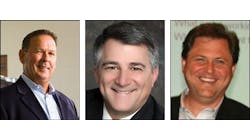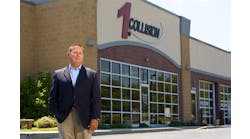Driving east on Interstate 80 from Chicago, you roll into Indiana at the town of Hammond, perched on the eastern edges of Chicago’s southern suburbs. For a time, what served as a gateway to the community was a vacant Dodge dealership, visible from the interstate. While many might see such a building as blight, Chuck Freiberg, owner of Collision Damage Experts, saw it as an opportunity. Freiberg built his career transforming old dealer body shops into locations for his independent collision repair company, which had three Chicago-area locations before Freiberg spotted the old Dodge dealership on I-80.
Although Hammond already sported numerous body shops, including three outfits just down the block from the Dodge dealership, Freiberg decided to take the plunge. He bet that new waterborne technology, a focus on improved workflow, and a stunning renovation would spell success for his new venture.
“I wanted to have the highest quality, awesome-looking building—something you would see from the outside and think, ‘This is a body shop?’” says Freiberg. “But then we had to back it up with something, and that’s where our standards for quality come in.”
Freiberg’s bet is paying off. Just open for business since September, Collision Damage Experts already completes 35 cars per month and is projected to finish the year with sales of more than $3 million. Freiberg has poured his 28 years of experience owning and operating body shops into making the Indiana CDE something special.
“I didn’t know for sure that this shop would be successful,” he says. “But I liked the area, and I knew I had a lot of strong competition. I respect the shops around here for what they’ve accomplished, but I wanted to see what we could do here. It’s all about relationships and quality.”
The Daring Entrepreneur
Relationships, quality and bold moves have been important to Freiberg since 1982, when he approached the owner of a Chicago dealership and asked if he could lease the repair shop. Freiberg had worked there six years, and the owner, who wanted to get out of the collision business, agreed. A year-and-a-half later, Freiberg did it again, asking another dealership owner to lease him the shop.
Freiberg grew his collision repair business on the southeast side of the Chicago metro area, eventually buying the second shop, opening a third Chicago location in 1997, and a fourth site in Lynwood in 2000. (The dealership owners of Freiberg’s first shop never would sell to him, and he lost his lease this year. That company subsequently went out of business.)
With designs on further expansion, Freiberg kept his eye on Hammond. The way Freiberg envisioned it, the shop’s outward appearance would look nothing like a typical auto repair center. He wanted to reuse the existing building, but it screamed dealership. So Collision Damage Experts completely refaced the exterior and gutted the interior. In went stone and glass, brick pillars, new doors, large windows and a gleaming 16,000-square-foot interior that is designed for efficiency and productivity.
Waterborne for the Newborn Shop
In addition to the crisp, clean, vibrant paint jobs that waterborne products create, Freiberg was excited to get ahead of the curve by adopting more green painting methods at the Hammond location.
At the same time, he converted his other three locations to waterborne shops. The trick was figuring out which system to use. Freiberg vetted numerous paint and systems suppliers, picking those that offered extensive training to shops to adapt to waterborne.
When looking at suppliers, Freiberg had three main priorities: 1) quality of the finished product, 2) ease of use for applying the paint and 3) active support and training for the transition. Freiberg selected AkzoNobel after evaluating three paint suppliers. He favored the quality of its finishes and the deep support company representatives offered as CDE installed the new systems in Hammond and converted the other shops.
The supplier trained CDE technicians at its training facility in Lombard, Ill., for a full day. Company technicians also came to the CDE shops to demonstrate how to best apply its paint. Then, reps stuck around the shop for two weeks to make sure CDE technicians were comfortable with the product once they were painting on their own. “There was so much support, we didn’t have a hiccup,” adds Freiberg.
The cost: about $70,000 each for the three new paint booths in Hammond, and about $30,000 each to convert CDE’s seven other booths from solvent paint to waterborne paint—roughly $420,000.
The collision center in Hammond also installed Global Finishing Solutions’ AdvancedCure air filtration system and air accelerator to keep the shop pristinely clean. “They’ve got to have a good air supply—clean, dry air and plenty of it,” says Dan Fennema, wholesale account manager for AkzoNobel. He favors rotary screw air compressors, which produce dry, clean air very efficiently. Using powerful air compressors and accelerators in the paint booth increases the air flow around the vehicle, which speeds drying time.
The decision to create a more earth-friendly collision center has been essential to Freiberg’s early success with the Hammond shop. Freiberg is amazed at the fantastic paint jobs his shop is able to turn out since it switched to waterborne paints. By far the new paint is his favorite part of the Hammond shop. “For us AkzoNobel had the ultimate ease of use and very high quality. I’m very comfortable saying at this point that I could not be happier,” he says. “It doesn’t just bring the car back to the original condition—it’s 120 percent of the original.”
An added bonus to using waterborne paint is the productivity boost from time shaved off the repair cycle. With solvent-based paint, CDE was constantly buffing the cars to remove dirt and dust particles. Now, technicians wash the cars several times during the process and just buff small areas as needed.
CDE now spends less money on buffing papers and compounds, and it saves the detailers a ton of time. Instead of taking 50 to 75 minutes to paint the car and 30 minutes to bake it dry, the shop now can finish a car in 35 to 40 minutes for painting and 20 minutes or less for drying. It goes so quickly because painters need to do only one-and-a-half to two applications of waterborne basecoat compared with three to four coats of traditional paint. Overall, that has slashed cycle time to three to four days instead of five to five-and-a-half days, notes Freiberg.
He’s also seeing savings in materials: Soap and water have replaced solvents to clean solvent-based paint off mixing and spraying equipment.
Productivity Perks
Freiberg doesn’t attribute all of this newfound productivity to the waterborne paints. Lean operations at Hammond have provided a lesson or two about streamlining workflow to his other locations. The first step was having shop technicians work in teams rather than individually. That way the shops can pair more experienced workers with newer or less-skilled employees, and they can take care of tearing down cars while the veteran techs focus on the painting or body work.
Other changes that have made CDE more efficient:
Parts. Employees thoroughly assess and document every part needed for a job, so that nothing gets left off an order. The parts department makes sure all elements are in stock or located nearby. If not, CDE searches the country for the needed parts and has them shipped overnight to drop into the cycle when needed.
Receiving. When parts arrive at CDE, employees open boxes immediately and note missing or broken pieces. Problems are fixed before they slow the repair process.
Measuring. CDE uses a laser touch measuring system for structural repairs. The system guides technicians to point and click at designated areas. This makes estimating and measuring vehicles for repair much quicker and more accurate, and keeps repairs moving along.
Efficiency software. CDE deployed Mitchell Repair Center software to run all four of its shops efficiently. It sets standard operating procedures for repairs. The procedures are uniform to each shop so that technicians from all CDE locations can work at any shop when demand is higher.
Responsive service. CDE also has embraced using technology for communication, installing AutoWatch so that customers and insurance companies can, literally, keep an eye on vehicles moving through the repair process. Photographs of the repairs let customers follow their cars during each stage, and they can easily email their service representative with questions or concerns. In addition to reducing phone calls, AutoWatch boosts business by highlighting other issues outside of a claim that customers choose to repair.
A Family Affair
Freiberg says he would be remiss if he didn’t credit some of his success to his family. His parents always supported him, notably after he wrecked his 1967 Firebird as a teenager and fixed it himself without any repair experience. They let him repair their cars, and drummed up more business from family and friends. When Freiberg got stretched thin with his two locations, his dad, Bill, quit his construction job and took the reins at one shop. Ultimately Freiberg’s mom, Rosemarie, did CDE’s books. These days, Freiberg’s two sons, Eric and Brian, are learning the ropes, one as a technician and the other in management.
Three generations of Freiberg have kept CDE in business for nearly 30 years. Freiberg hopes his fourth location is the beginning of a friendship with Indiana collision customers.



